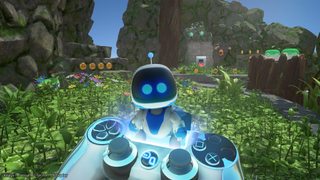
PSVR 2 is official, and with reports stating that Sony’s virtual reality device could hit store shelves as early as Christmas 2022, it’s arriving a lot sooner than the original PS4 headset did for that console generation. If you’re one of the lucky few to have nabbed yourself a PS5, then you might not have to wait overly long to experience Sony’s next crack at virtual reality tech.
One recent rumor does have me somewhat concerned, though, and it’s that PSVR 2 might see a shift away from dedicated VR experiences in favor of ‘hybrid’ titles that support play with or without the PSVR 2 headset. And while that doesn’t seem like much of a problem at face value - after all, having the choice to play either version is a good thing - I can’t help but feel like Sony is missing a huge opportunity to make PSVR 2 stand out with purpose-built, AAA VR experiences you can only get on PS5.
But what do I mean by purpose-built, exactly? Put simply, ‘purpose-built’ in this case would be a game designed from the ground up exclusively for play on the PSVR 2 headset. This means you would only be able to play the game with the headset, as it would be a bespoke experience that’s impossible to play without the peripheral.
- Where to buy PS5: all the retailers to check
- PS5 vs PS4 Pro: should you upgrade?
- PS5 vs Xbox Series X: which next-gen console should you buy?
The original PSVR boasted some VR-exclusive titles that were genuinely brilliant, making this potential shift in strategy a shame. Among them were Astro Bot Rescue Mission, a superlative platformer that played to the strengths of PSVR to deliver a unique and innovative experience. There was also Deracine, From Software’s take on VR that strayed entirely from Soulsborne action to deliver an atmospheric, often haunting narrative adventure.
Of course, this hybrid approach to PSVR 2 game development isn’t anything new, as plenty of titles that could be described as such existed on the original PSVR headset. Resident Evil 7 comes to mind, which introduced many players to virtual reality horror in first person, and did so very successfully, while offering the same core game from a traditional TV display, too.
Ace Combat 7 and Wipeout Omega Collection also featured blisteringly fast VR modes that were admittedly a bit much for my queasy, unfit human shell, but definitely provided examples of virtual reality genuinely enhancing what would otherwise be a TV-only affair.
So now that I’ve waxed lyrical about the hybrid, ancillary approach the original PSVR took to many of its titles, why do I suddenly have an issue with the same process being carried out on PSVR 2?
Get daily insight, inspiration and deals in your inbox
Get the hottest deals available in your inbox plus news, reviews, opinion, analysis and more from the TechRadar team.

PS5 boasts more power than ever
Part of it lies in performance. The PS5, obviously, is demonstrably more powerful than its predecessor. As such, it’s reasonable to expect that PSVR 2 will be capable of running more demanding games. This is somewhat supported by a discussion on Digital Foundry Weekly, wherein host Richard Leadbetter mentioned: "we’ve seen some leaked [PSVR 2] specs and it looks good [...] we’ve seen some other specs which haven’t been leaked which make it look even better."
Obviously nothing is concrete as of yet, but it sounds like PSVR 2 could have the potential to run games akin to Valve’s VR watershed Half-Life: Alyx, or the ultra-immersive Elite Dangerous VR. And with the PS5 arguably being the most powerful console on the market right now, it has a shot of ushering in the next revolutionary wave of VR titles.
Sony shouldn’t be settling for second best here. The first PSVR headset was relatively affordable compared to the likes of the HTC Vive or Valve Index. However, it greatly lagged behind in terms of specs. PSVR 2 has an opportunity to still be somewhat affordable, while ballparking the PC quality visuals the likes of Valve and Oculus can offer.
One issue I could never quite get past with the original PSVR headset was the relatively low, soupy resolution. Games like Skyrim VR were practically impossible for me to play on the base PS4. Not just because it was a VR version of an often-sedate game, but also because the resolution was low (to help maintain a smooth framerate, in fairness) to the point of making me feel sick. A higher resolution should be more than doable on the upgraded PSVR 2, allowing for much more ambitious titles to flourish.

Sony's back catalog is legendary
Another reason why Sony shouldn’t ditch VR-only experiences? The company has a back catalog of IPs that remain iconic to this day. PSVR 2 represents an opportunity for the company to bring classic franchises back with bespoke experiences, while contemporary series like Horizon, The Last of Us and God of War do the legwork on PS5.
Here’s a few examples that I think would work fantastically in VR and, granted, while these are pipe dream ideas, show that Sony could miss out on the potential PSVR 2 has if it wants to stick to hybrid titles only.
Remember how strangely atmospheric the levels in the Sly Cooper series could be? Adopt that in a first-person VR setting and series fans could be in for a real treat. Controlling Sly and the gang from a VR viewpoint could allow for a more grounded, stealth-oriented approach to the usual happy-go-lucky thievery seen in previous games.
Virtual reality has also shown it can mesh well with unconventional visual styles, too, as we’ve seen with Trover Saves the Universe, Beat Saber and Job Simulator to name a few. That’s why I posit that a PaRappa the Rapper VR game on PS5 should be priority one from Sony. Not only has the world suffered far too long without the rapping dog and his pals, but his papercraft-inspired world would be such a delight to explore in a virtual reality setting.
Of course, it would be great to see some classic third-party franchises commit to big returns on PSVR 2. Ridge Racer’s breakneck drifting would be utterly exhilarating in VR (if you can stomach it), and with the right developer, I’d find it very hard to turn down a Silent Hill virtual reality game, so long as I bring a spare pair of trousers.

The case for hybrid VR?
Games that can be played on both the TV and in VR isn’t a bad concept in and of itself. And as mentioned above, Sony implemented the hybrid strategy to pretty great success on PS4. I can no longer imagine playing Thumper or Rez Infinite any other way now, for example, despite offering solid TV-based experiences.
If Sony is to continue this strategy, then, it would be coming from an informed position at the very least. Players did like that games weren’t locked away behind a $299 / £249 headset, and could just as easily be played on their existing console setup.
However, as VR titles continue to grow in ambition each year, I think it would be fantastic for Sony to grab a slice of this momentum and really encourage its first party devs to create unique (perhaps exclusive) experiences on PSVR 2. It could give VR enthusiasts a real reason to invest in a PS5 and PSVR 2 headset, if they’ll be able to play excellent VR games they couldn’t get anywhere else.

Rhys is TRG's Hardware Editor, and has been part of the TechRadar team for more than two years. Particularly passionate about high-quality third-party controllers and headsets, as well as the latest and greatest in fight sticks and VR, Rhys strives to provide easy-to-read, informative coverage on gaming hardware of all kinds. As for the games themselves, Rhys is especially keen on fighting and racing games, as well as soulslikes and RPGs.
